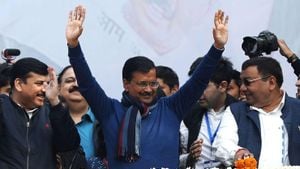The political climate of Delhi is ablaze with the results of the 2025 Assembly elections, as counting commenced at 8 AM today, with early trends signaling significant shifts. According to reports from various news outlets, including The Times of India, the Bharatiya Janata Party (BJP) is leading with early leads observed across numerous constituencies, challenging the Aam Aadmi Party (AAP) which has been at the helm since 2015.
Initial figures indicate BJP leading or securing victories across at least 46 seats, with AAP trailing at 23 seats and the Congress party hovering around 1 seat. BJP's Kapil Mishra is reportedly leading the charge with significant margins, as the results continue to filter through. AAP’s Arvind Kejriwal, defending his seat in New Delhi against BJP's Parvesh Verma, is currently behind, indicating potential challenges for the incumbent Chief Minister.
With approximately 70 assembly seats contested, the stakes are high for AAP, aiming to secure its fourth term, buoyed by strong welfare schemes promoting free utilities and education. The BJP, on the other hand, has ramped up its campaign, emphasizing issues like inflation and governance under Prime Minister Narendra Modi.
This election is pivotal not just for Delhi’s governance but also for national politics. The election results point to possibly changing electoral dynamics, particularly among the Muslim electorate, which constitutes a significant portion of Delhi's voter base. Reports suggest areas with high Muslim populations like Okhla and Mustafabad are being closely monitored for their voter preferences. The dynamic here shows AAP losing ground, with historical trends indicating their previous dominance might be contested significantly.
Voting data shows Mustafabad and Okhla registering commendable voter turnouts of 69.01% and 54.96%, respectively. The increased involvement hints at the acute political awareness among voters, driven by key local issues ranging from local governance to social welfare. Notably, the AIMIM has also emerged as an influential player, contesting several seats which could fragment the traditional AAP support base.
Key battlegrounds like Jangpura, Kalkaji, and Malviya Nagar have also seen interesting contests. Jangpura, featuring AAP’s Manish Sisodia, is still too close to call, as he battles BJP’s Tarvinder Singh Marwah. The results from this affluent constituency could significantly impact the overall picture. Meanwhile, CM Atishi finds herself behind BJP's Ramesh Bidhuri, highlighting the reversal of fortunes for AAP's heavyweights.
Social issues remain hot topics among candidates, with both AAP and BJP seeking to present solutions to the pressing concerns like inflation and public welfare. The AAP's promises of free water and electricity continue to resonate with voters, but recent allegations of corruption surrounding their governance could weigh heavily on their current standing.
With every update, the narrative of the Delhi elections is solidifying—a narrative of shifting allegiances and priorities. The Congress party, striving to regain its foothold, finds itself attempting to siphon off votes where possible but shows signs of struggle, with predictions indicating almost no lead elsewhere except odd spots.
It is noteworthy how effectively BJP has capitalized on voter sentiments, especially with the rising middle-class discontent over everyday governance issues. BJP leader Mohan Singh Bisht has left AAP’s Adil Ahmad Khan trailing in Mustafabad—a constituency previously regarded as secure for AAP.
The dynamics surrounding the minority vote are particularly pivotal this election; with Muslim voters making up significant portions of constituencies like Okhla and Mustafabad, their turnout and preferences could determine the fate of parties. Historical data suggests AAP held strong support among these voters, though recent shifts show BJP’s outreach may have altered traditional voting patterns.
The counting proceeds under heightened security with over 5,000 Election Commission staff overseeing the events to prevent any discrepancies. The smooth functioning of Electronic Voting Machines (EVMs) reflects positively on the electoral process, indicating readiness to handle the walls of anonymity as votes are counted.
Observers are intently watching how various constituencies align with overall trends, particularly considering the national stakes. AAP’s narrative asserts it can overturn exit polls which heavily predict BJP wins marked across the anticipated 40-55 seat range—a bold claim indicating confidence but challenged by early signals. A hung assembly could trigger another unpredictable coalition faze—with AAP and Congress possibly reconstituting efforts to leverage their combined strength against BJP.
With murmurs about BJP’s potential return to power after nearly three decades of absence, the factors at play—from AAP’s welfare schemes to BJP’s nationalistic fervor—continue to paint this electoral battle as not just local governance but integral to the larger narrative of Indian democracy.
Whether the lotus will finally bloom again or if the broom will continue to sweep the national capital remains to be seen. The people of Delhi await patiently, and the world watches closely as the results continue to roll out, set to reshape political narratives across the board.



